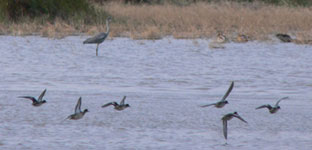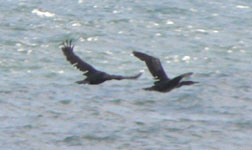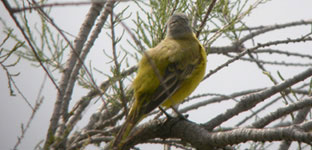|
 |
Site Details: |
|||||||||||||||||||||||||||||
Trip reports from participants of Catalan Bird Tours' birding holidays and bird watching tours to the Aigüamolls de L'Empordà and Cap de Creus are posted here.My own blog and photos are also below. |
|||||||||||||||||||||||||||||||
TRIP REPORTS: |
|||||||||||||||||||||||||||||||
For more Trip Reports: |
|||||||||||||||||||||||||||||||
Date/Time |
Author |
Clients |
Site |
||||||||||||||||||||||||||||
25 September 2006 |
Stephen Christopher |
Bill and Helen Dick, England |
Cap de Creus / Aiguamolls |
||||||||||||||||||||||||||||
“We really enjoyed our day (in fact, we called back in at Aiguamolls on the way to the airport), so as soon as my computer is OK, I will send you some comments...” (!)Bill and Helen Dick |
|||||||||||||||||||||||||||||||
|
Teal and Grey Heron
|
Shag
|
||||||||||||||||||||||||||||||
 |
 |
||||||||||||||||||||||||||||||
| 20 may trip report | |||||||||||||||||||||||||||||||
20 May 2006 |
Stephen Christopher |
Marjolijn Van Delft +40, Holland |
Aiguamolls |
||||||||||||||||||||||||||||
“I want to thank you again for your tour. We really enjoyed it and everyone was really enthusiastic about it. We all study different aspects of biology... we learned a lot and you were able to answer all of our questions.We were very happy and thankful that you made it possible to visit this beautiful piece of nature of Spain. We have seen a lot of interesting and beautiful species.”Marjolijn Van Delft, Holland
When I was asked to lead a group of Dutch biology students on a tour to the Aigüamolls de L’Empordà, I was a little concerned that the size of the group (over forty 19-26 year olds plus a few lecturers) would make it difficult to spot birds, let alone expect them to hang around long enough for everyone to gather round so I could talk about them.Despite this, having satisfied myself that splitting them into two groups and my degree in zoology would be enough to make the day work, I accepted the task and set about planning a series of ‘set-pieces’ to punctuate the impromptu stuff.However, when they poured out of the coach, most of them without binoculars, and I was told they had literally just driven the eighteen hours from Holland non-stop – save for a breakdown! – I almost jumped back in the car and fled.I’m glad I didn’t. From the moment when came the first of many eager interruptions as a small section couldn’t contain their excitement at seeing adjacent Squacco and Purple Herons, to the scramble for hand-shakes and photographs at the day’s end, I had an absolutely fantastic time.Of course the birds played their part too, as the Swifts and Swallows over the rice-fields at Mas Matá allowed me to start the tour talking about migration and, how many birds, such as the current flock of waders and the recently departed Red-throated Pipits, time their journey to coincide with the region's flooding.A careful scan across the site revealed that, of all the species of wader, each was occupying its own feeding niche, the depth of water or mud dictated by the birds’ specific physiological adaptations. In this case, the shapes and lengths of their bills. From short to long, my classroom demonstrators for the day included Little Stint, Ringed Plover, Wood and Curlew Sandpiper, Black-winged Stilt and Pied Avocet.An eager, ‘what’s that?’ from a young man carrying a constantly-open field guide and pointing at a passing Whiskered Tern, was the sole interruption to a discussion on the many sub-species of Yellow Wagtail that migrate through the area. But a flyby Collared Dove, flapping its way over a flock of Greater Flamingoes, fortuitously prompted me to ask, ‘Does anyone know what those two birds have in common?’When the answer (that they are, along with the Emperor Penguin and other doves, the only birds to produce milk for their offspring) was greeted with the surprise I expected, I took advantage of their interest and moved on to my ‘bird song spot'.Silently settled between the walls and canopy formed by reeds and riparian trees, we listened to the songs and calls emanating from choristers deep beyond them. Amongst other topics, we mused on why many species reliant on song for finding a mate are typically dull in their plumage. The Nightingale and Cetti’s, Reed and Great Reed Warblers all helped to make the point. The fact that they also obliged us with unusually close ‘binoculars-down’ views was only failed to be appreciated by the students because most of them didn’t have any binoculars to put down.The quite fascinating mating exploits of the Penduline Tit were appreciated, however, and the (partial) explanation of the sexual dimorphism shown in birds such as Mallard, Marsh Harrier and Common Pochard, regarding responsibility for egg incubation, initiated a chorus of ‘I knew I knew that’ recognition.A lone Cuckoo and the massive, chick-filled nests of the White Storks initiated discussions on survival instincts and the validity of man's interference with re-introduction schemes until an excited runner from my first group, exclaiming that he’d found a pair of Roller and beckoning us to follow, provided a timely end to proceedings and we headed back to the coach via them and a bank of Bee-eater nests. |
|||||||||||||||||||||||||||||||
|
Iberiae 'Spanish' Yellow Wagtail
|
Curlew Sandpiper
|
||||||||||||||||||||||||||||||
 |
 |
||||||||||||||||||||||||||||||
|
a
|
|||||||||||||||||||||||||||||||
6 April 2006 |
Stephen Christopher |
Sunshine |
Aiguamolls |
||||||||||||||||||||||||||||
|
There a very few places I prefer to be when I’m exhausted than sitting in the single, sleepy hide at Vilaüt, in the Aigüamolls de L’Empordà. In all the years I’ve been visiting it I think I’ve only ever seen two people there, which is incredible considering what an absolute marvel it is in terms of birds. I mean it’s just a wet field in the middle of some other fields but, for some reason, the birds like it and something always turns up to join the site’s famed Roller, Great Spotted Cuckoo and, perhaps still, one of only two breeding populations of Lesser Grey Shrike in Catalonia (and Iberia!). I can’t pretend I wasn’t disappointed then when a disparate collection of Mallard was all there was to greet me as I approached the gap between the trees that always offers me my first excited peek. The build up via the farmland dirt track had promised much, with startling spring pairs of Northern Wheatear, Stonechat and Whinchat all competing for space in my notebook, but the vacant expanse now before me began to tease out a guilty regret that I had stayed in slumber rather longer than I had intended this morning. And then, bang on ironic cue, and seemingly urged on by the metaphoric alarm clock of the rhythmic tock-turring of Red-legged Partridge, the site began to awaken. Tree Sparrows began to chatter around the hide, perhaps impressed by the Wood Sandpiper’s ability to melt out of nothingness, and a whole section of field just a few metres away decided to reveal itself as a rather large flock of gleaning iberiae Yellow Wagtail. It always does this. And I always forget. Everything seems to stop, like a group of actors on stage politely waiting for a latecomer to take his seat, until you’ve unpacked your flask and poured out a cup full of wake-me-up. Then, once you’re comfortable, the plot continues, rising and falling in fits and starts before presenting you with the finale. In the past this has meant anything from my first Short-toed Eagle (Culebrera, or Snake Eagle, in Spanish), blankets and blankets of waders or a lone Common Crane to keep me company but today, today was a real fanfare. As a dark-phase, Booted Eagle (Calcada oscura locally) floated down from the right, it was simultaneously joined from the left by a superb adult Culebrera. And then from high, high above – and I have no words to describe this – a Pescadora (or Osprey) swooped gently down to complete the circus of friends cart wheeling and pirouetting on the stage that is Vilaüt. Re-invigorated and, not surprisingly, no longer sleepy I made my way to the noisy El Cortalet reserve chaperoned, to the car at least, by scooping and screaming hirundines and two species of swift, Common and Alpine. Whiskered Tern, Lapwing, Glossy Ibis, Hoopoe, Lesser Short-toed Lark, Woodchat Shrike, Marsh Sandpiper, Purple Heron, Melodious Warbler and Little Owl all provided the highlights. Of the second part of the day at least. |
|||||||||||||||||||||||||||||||
|
Northern Wheatear
|
Marsh Sandpiper
|
Black-tailed Godwit
|
|||||||||||||||||||||||||||||
 |
 |
 |
|||||||||||||||||||||||||||||
|
|||||||||||||||||||||||||||||||
